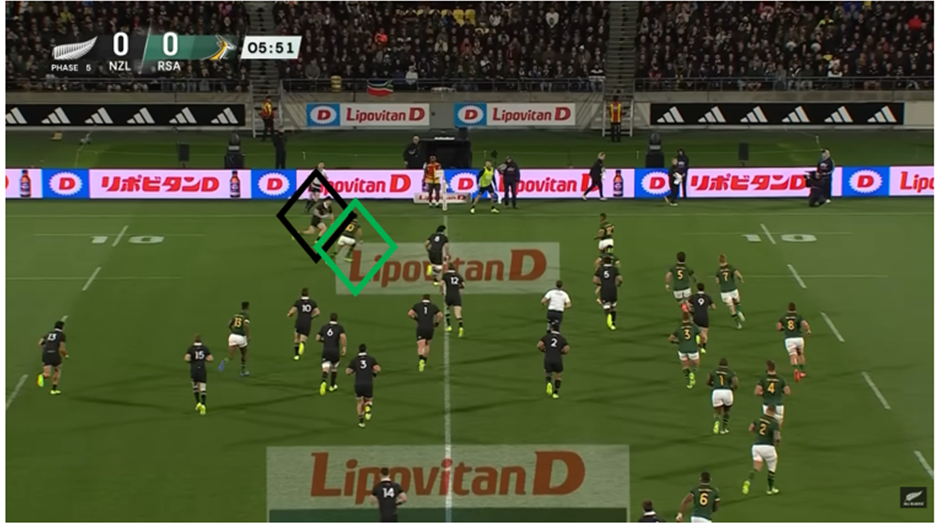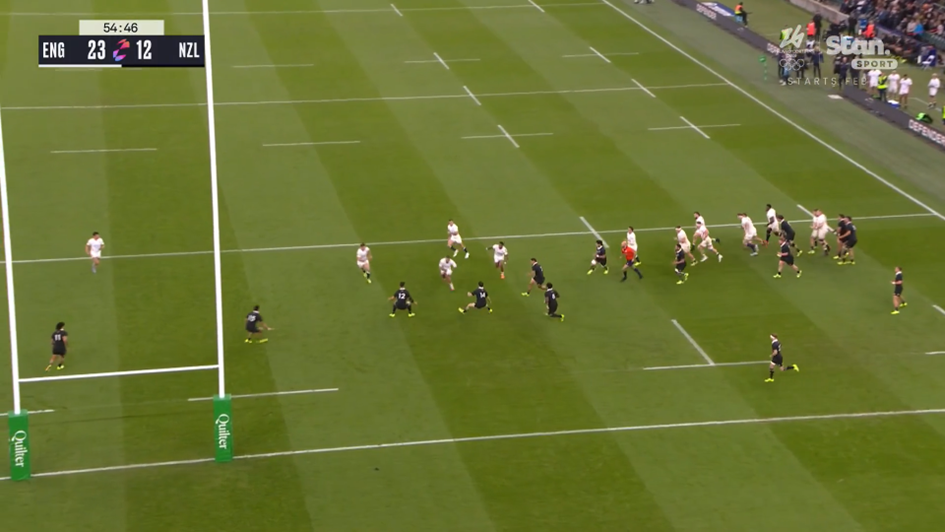During the second half of Saturday’s AB XV game against England A, former England and Bath outside back Matt Banahan made an astute observation while commenting on the game. “There’s definitely been a tactical change for All Blacks XV in the second half with the high cross-fields to catch the wingers under the ball, so they don’t have the open field [to counter-attack] and these centre-field kicks from 9.” As these words were leaving his mouth, Havili threw a beautiful bridge pass over the head of England A winger Noah Caluori to put Sevu Reece into space. Just seconds later, Reihana would finish the move by dotting down underneath the post.
So why did this tactical shift take place? Banahan already mentioned the first part: by targeting the kick space on the edge, the AB XV could take away one of England A’s main threats in the first half, their counter-attacking platform from centre-field, through which they set up their dangerous attacking shapes. Because while England A fumbled their way through that first half by dropping nearly every pass, they had created several line break opportunities, with only their lack of hands preventing further scores.
But there is another, more attacking reason for these kicks as well. This second reason is more concerned with the opposition rush defence – specifically, the role of the backfield cover and the outside defensive shooter – and how the AB XV attack could circumvent these back 3 defenders. It also brings the midfield bridge pass back into play: simply passing over the rush defence isn’t enough to actually break down this defensive structure. You also need to manipulate the numbers and field position of the opposition defence beforehand.
In this sense, the AB XV has shown some nice attacking nuances and developments which may well be implemented soon with the senior side. So what were these nuances?
Breaking down the AB XV Reihana try
While the Reihana try at first glance might look like a relatively straightforward backs move – setting up a few rucks before throwing the wide ball – there are a number of components to it which are crucial for the move to work. They are crucial because they change the way England A is able to defend the strike. These 3 components are: 1. The Fakatava box kick, 2. The midfield ruck, and 3. The AB XV backline realignment to the openside.
The kick
After an AB XV scrum in their own half, the All Blacks XV cart it up once before Fakatava sets up the box kick into England A territory.
https://media4.giphy.com/media/v1.Y2lkPTc5MGI3NjExZ3AwcGp1Z2t4djJ1OGZlcmI0OHd1ODN3bTVwbXo4NGRyNGVkbXRqcCZlcD12MV9pbnRlcm5hbF9naWZfYnlfaWQmY3Q9Zw/g6NKcrE2oIN43Ix1AX/giphy.gif
Fakatava box kick
While this kick might seem innocuous enough, the purpose of it is threefold. The AB XV want to (a) regather possession, (b) bring the England A fullback, Josh Hodge, into play and pull him out of the backfield cover and (c) force the England A first five, Charlie Atkinson, into the fullback defensive positioning on the openside.
All of these targets are met as Hodge is unable to gather cleanly under pressure from Tangitau, with the England A fullback now brought out of position and Atkinson now moving into the open backfield, to cover the opposite edge.

Atkinson (10, red) is moving to the defensive openside to cover the right edge. Meanwhile, Reihana (22, black) is already organizing the shape for the Havili cut-out ball 2 phases later
The midfield ruck
After the ball is regathered from the box kick by Fakatava himself, the temptation might have been to immediately swing the ball wide, in order to exploit any potential defensive chaos. Fakatava, however, resists such temptation and instead takes the ball into contact, setting up a ruck on the right edge.
We can already see Reihana, in the picture above, taking matters into his hands and organizing the attacking shape for the phases to follow. After the Fakatava ruck, another two rucks will be set up, each one moving closer and closer to the centre of the field, until the ball is eventually presented straight in the middle.
https://media0.giphy.com/media/v1.Y2lkPTc5MGI3NjExdm5uY2Mya2N1MHZ3ZjdwaHk1ZXZ2aXo4cTI3dGIweWNtN3VoaWVpZCZlcD12MV9pbnRlcm5hbF9naWZfYnlfaWQmY3Q9Zw/LnJFTsRynzNAJcFpdH/giphy.gif
Setting up midfield ruck
This, again, is an intentional ploy. The goal here is twofold: (a) to split the England A defence down the middle, so they don’t have a full defensive line to rush with, and (b) to realign the backline in anticipation of the attacking launch from the midfield ruck. While the forwards are moving the ball to the middle of the field, the backs are all realigning to the left edge, so that when the midfield ruck is set up, we get this picture.

Nearly the entire backline – Havili, Ennor, Reece, Tangitau, Jacomb and Reihana – are bunched together in a 20 metre-channel from the side line, in anticipation of the outside break
This brings together two things: pace and ballhandling. So when the outside break is made via the Havili bridge pass to Reece, the outside channels are flooded with pacy players who can execute any numerical mismatches with ease.
The backline realignment
It is now that the risk of the extra rucks in midfield starts paying off: the AB XV have huge support numbers which can flood the channel after Reece has made the outside break. Both Jacomb and Reihana already start sprinting towards the space on Reece’s inside shoulder even while Havili’s bridge pass is still in the air.
https://media2.giphy.com/media/v1.Y2lkPTc5MGI3NjExcWhrODR1bGZ2bGRtbnhldmg2cDhsY3VpMHJhZzRleDc5NHN6YmthaSZlcD12MV9pbnRlcm5hbF9naWZfYnlfaWQmY3Q9Zw/6nYOutAuk1988H8Kbn/giphy.gif
Havili bridge pass
This also further reinforces the value of the box kick: the England A backfield cover defence has the responsibility of shutting down any outside breaks, yet Atkinson, as a first five rather than an experienced defensive fullback, is slow in closing down the space for Reece to run into. While Josh Hodge isn’t a good defender by any means either, the logic of the kick is still sound: it forces the defensive backfield to move and realign, which can make the eventual exploitation of the backfield space a bit easier.
Meanwhile, the value of the midfield ruck is also clearly visible: the English defensive line was strongly pushing forward so, after the outside shooter was passed by through the bridge pass, they didn’t have the time or space to catch up to the AB XV support runners who were already in motion. If the AB XV had gone wide immediately from their ruck all the way on the edge, any break on the opposite edge would’ve been faced with a defensive scramble in full-motion, which makes it much harder to outpace.

The English defensive line is still in structure rather than in scramble mode. This has the effect that they’re miles away when any line break is made on the edge
The value of these particular components – box kick, midfield ruck, backline realignment – becomes even further emphasized when we compare it to a similar attacking launch point, performed by the senior AB side in Wellington against the Springboks in September.
Getting swallowed by the scramble
A few months ago, I wrote about that Wellington Test that it showed a lack of clarity in the AB game plan in its attempted combination of tactics and technique: “Tactically, there are too many links in the chain and technically, there are not enough links that can do what is asked of them.”
This referred to a specific launch play in the first minutes of the game, where the ABs set up a ruck on the right edge and tried to go wide immediately.
https://media3.giphy.com/media/v1.Y2lkPTc5MGI3NjExejQxZXd6bHUxYzRheTk2cDN6Yzd0anhjY3Bqcjl4eW9kaWFoOTV0NSZlcD12MV9pbnRlcm5hbF9naWZfYnlfaWQmY3Q9Zw/8JpTP98CWtfaIKVTHD/giphy.gif
Wellington edge ruck launch
The differences to the AB XV strike are considerable: (1) there is no use of the box kick to manipulate backfield cover and draw Bok defenders up, (2) there is no midfield ruck to split the Bok rush, and (3) there is no backline realignment to the open to put pace and support into the space after the outside break.
This was the eventual result:

When Leroy Carter (11, black) receives the ball on the edge, he is already covered by the Bok first five – Feinberg-Mngomezulu (green) – as the latter didn’t have to realign in his backfield coverage due to a lack of kicking. The Bok defensive line is also still ahead of the ball and is in full movement.
And rather than a full backline in support – remember the full AB XV backline inside a 20 metre radius around the ball – the closest players to Carter are Sititi, Jordie Barrett and Tuipulotu. Beauden Barrett, McKenzie, Proctor and Will Jordan are still around the middle of the field or even further away, and are in no position whatsoever to help exploit any line break that is made. Even if Carter is able to beat his man, there are no means for the ABs to actually finish any break that is made.
Instead, what the AB XV have done, to combat principles of rush defence, is to borrow from the Wallaby game plan in Ellis Park. Set up midfield rucks to split the Bok defence, use the bridge pass to get over the outside-in defensive shooter and flood the outside channel with pace and support (Frost, O’Connor and Wright are all in close support around Jorgensen).
https://media0.giphy.com/media/v1.Y2lkPTc5MGI3NjExNXM1NHB4dzJva3dub2VnMjlvZG95bGh6aGhjeGl4M2UwbWc0MTN3NyZlcD12MV9pbnRlcm5hbF9naWZfYnlfaWQmY3Q9Zw/IKYO7C3LTn52ziuqa0/giphy.gif
JOC Ellis Park bridge pass
It is good to see that NZ coaches aren’t too proud to borrow what works from others and to shelve those plans – edge ruck launch platforms against rush D – that simply haven’t produced the goods.
I ended the Wellington-piece with the following thoughts: “Now firmly in the bottom of TRC skillsets, it is time for NZR to seriously address either the way they want to play the game or the manner in which they build their skillsets, as right now both facets of the game aren’t complementary of each other. While Wellington might not represent the end of future NZ rugby supremacy, it certainly signals a fork in the road, with administrators needing to make decisions and take action.”
With the tactical nuances and developments put forward by the AB XV, hope springs that administrators and coaches in the game have indeed taken note. And while it still remains to be seen whether the senior coaching team is pragmatic enough to swallow some of its pride and adapt, the AB XV have shown that rugby pragmatism in NZ rugby certainly isn’t dead yet.
















